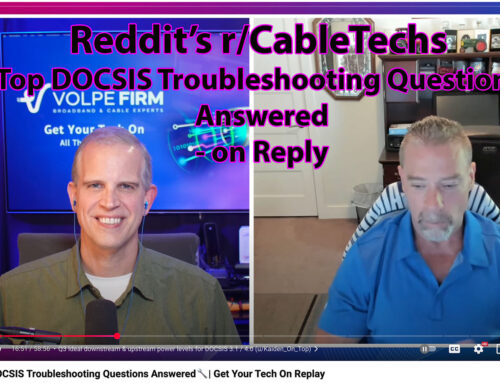Podcast: Play in new window | Download | Embed
Subscribe: Spotify | Email | RSS | More
Hello Everyone. This is episode 56 of Get Your Tech On, our show on All Things DOCSIS. I’m Brady Volpe, Founder of The Volpe Firm and Nimble This. John Downey is with me today. John is CMTS Technical Leader at Cisco Systems, welcome John. Today we are going to discuss DOCSIS 3.1 Channel Bonding
But first:
In the News:
- The latest issue of Broadband Library is out, so check out my article as many others at broadbandlibrary.com
- NCTC Inks New Deals – BTR
- How will the rollout of 5G wireless move forward? How will it impact Cable Companies?
- T-Mobile’s DSS warnings all hot air, claim AT&T and Verizon – https://www.lightreading.com/5g/t-mobiles-dss-warnings-all-hot-air-claim-atandt-and-verizon/d/d-id/757636?
- Dish to spend up to $500M on 5G network build in 2020 – https://www.lightreading.com/5g/dish-to-spend-up-to-$500m-on-5g-network-build-in-2020-/d/d-id/757600?
- Sprint cuts the price of 5G – https://www.lightreading.com/5g/sprint-cuts-the-price-of-5g-/d/d-id/757518?
From Watchers:
From Micheal:
“I’ve been looking for some guidance on upstream channel bonding for D3.1.
- With the differences in baud rates and the sharing of time slots, should we be bonding the 3.0 and 3.1 on the upstream?
- My question is around the idea that if we do not bond the 3.0 would get access to all the time slots and not be waiting on 3.1 users.
- Additionally, how do the different baud rates interact when bonded. My understanding is that OFDM uses longer symbol rate which means a lower baud rate.
- If we allow the 3.0 to run without bonding is it actually faster than it is when bonded, almost twice the rate or is the rate 2X the OFDM rate and this works fine? Especially if we let the SC and OFDM run independently and allow two users to send concurrently rather than waiting on each other.
- With timing and baud differences, are we better off allowing two upstreams to run independently and not bond them?
- I have similar question on the downstream.
- Should OFDM and SCQAMs ever be bonded? With the differences in baud rates is OFDM holding the SC-QAM from being as efficient as it could be. Since OFDM is very wide in QAMs and SC is narrow it seems these would be easier to manage and work more efficiently if they are not bonded.
Let me know if you have any info on this. It’s a quandary as you try to go thru the math.”
End Podcast
John thank you for your time today. This was a great episode. Our next Episode 57 on March 27th at 2pm on Plant Balancing.
We do our best to bring our audience great technical content every month. You can watch us live on the air or catch our recorded episodes on YouTube, on our volpefirm.com/events channel or download our audio only version with your favorite podcatcher.
If you have enjoyed this webcast, please do hit the subscribe button so that you never miss an episode.
Thank you so much for being here and we will see you next month.
We do our best to bring our audience great technical content every month. You can watch us live on the air or catch our recorded episodes on YouTube, on our volpefirm.com/events channel or download our audio only version with your favorite podcatcher.
If you have enjoyed this webcast, please do hit the subscribe button so that you never miss an episode.
Thank you so much for being here and we will see you next month.
Upcoming events can be seen under Broadband Events. Previous events can be seen under the blog.
- If you are watching this on youtube please hit the subscribe button!
- Let us know what you think and remember to share!
- You can find slides at the bottom of the page and some on slideshare.
- Find out about events or articles by following us on Twitter, LinkedIn or Facebook too.
Also available on iTunes, Google Podcasts, Spotify, vurbl see podcasts “get your tech on”.





Leave a Reply